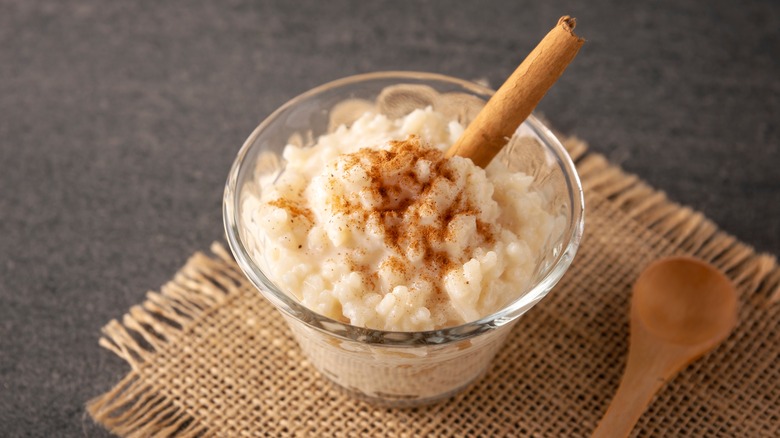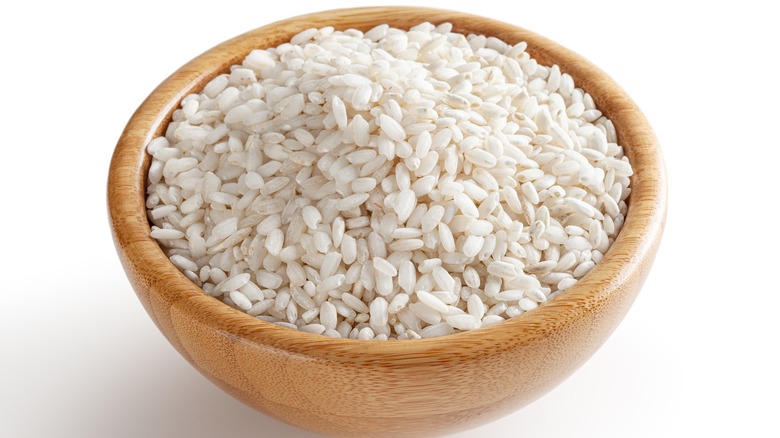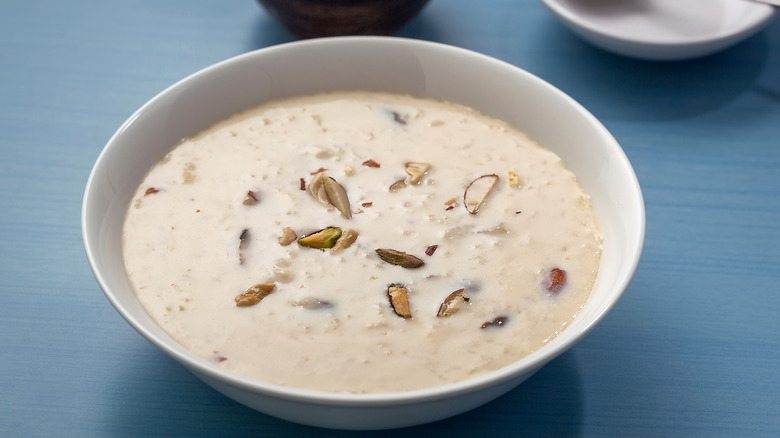The Best Type Of Rice For Rice Pudding
Is there anything more comforting and cozy to tuck into than a bowl of creamy rice pudding? The thought alone immediately evokes images of cozy fall days and rich cinnamon-y dessert bubbling away on a stovetop. A storied dessert with a rich many-thousands of years history, rice pudding has been enjoyed in various countries since ancient times and has taken many forms and been infused with countless cultural influences over the years. The treat has never gone out of style — still regularly popping up in modern cookbooks and on menus.
Few ingredients are needed for rice pudding — the treat makes good use of inexpensive household staples that with the addition of sugar, cinnamon, and milk, are dressed up into a sweet that feels decadent. Of course, it all begins with rice — the humble grain that can do it all, from breakfasts, dinners, or desserts. The type of rice you use is largely recipe-dependent and based on what you have in the cupboard, and while any will technically do, one type reigns supreme. Level up from your basic steamed brown or white rice and choose the Arborio variety — which provides a thick, custard-like base that lives up to the pudding descriptor, without going mushy. The short grain rice becomes perfectly creamy when used for risotto or rice pudding, thanks to its starch content, and provides a creamy, smooth base with a firm bite.
Arborio's starch content makes for creamy desserts
The world of rice is vast – with over 120,000 different typesin fact, and the typical modern grocery store very likely only carries a small sliver of the kinds of rice out there. For more specialized types, you might need to venture to an Asian food store or order from specialty online shops. Luckily, Arborio — an Italian variety — is readily available and affordable in most retailers, and easy to work with.
Varieties of rice range by length of the individual grains (short, medium, or long), color, texture, taste, and starch levels — which becomes important when making the perfect rice pudding. When whipping up what most of us think of as a classic rice pudding recipe, the plump-grain Arborio rises to the top of your options for the same reason it works so well in a creamy risotto recipe. The short grain rice has high levels of amylopectin, the starch naturally found in rice, and as it cooks on the stovetop this starch releases and forms a pot of just-sticky-enough, custard-y rice that perfectly lends itself to a pudding.
There's no one right way to make rice pudding
While most agree Arborio rice is king for creamy rice puddings, you'll still see plenty of recipes on the internet calling for long-grain types of rice — namely jasmine or basmati. Both of these types contain much less starch than other varieties meaning they stay separate and fluffy when cooked, rather than pudding-like. Unless they're all you have on hand, you'd probably be better saving these types of rice for other dishes.
However, the best kind of rice for the job also depends greatly on the type of rice pudding you're making. While Arborio is the best bet for a classic North American variety of rice pudding, recipes for the treat vary widely and appear in many cuisines around the world from Sweden to Greece, Portugal, Italy and beyond. Some styles are made on the stovetop, some baked in the oven with eggs for a more custard-like consistency, and they can be served hot or cold, with varying textures.
For example, if making the Filipino treat biko – a super-sticky sweet rice treat made with coconut milk — sticky rice (the type used in sushi) is the go-to variety, which when cooked has a far more glutinous texture than Arborio. The best rice for the job all depends on the recipe you're following and the texture you're chasing.


